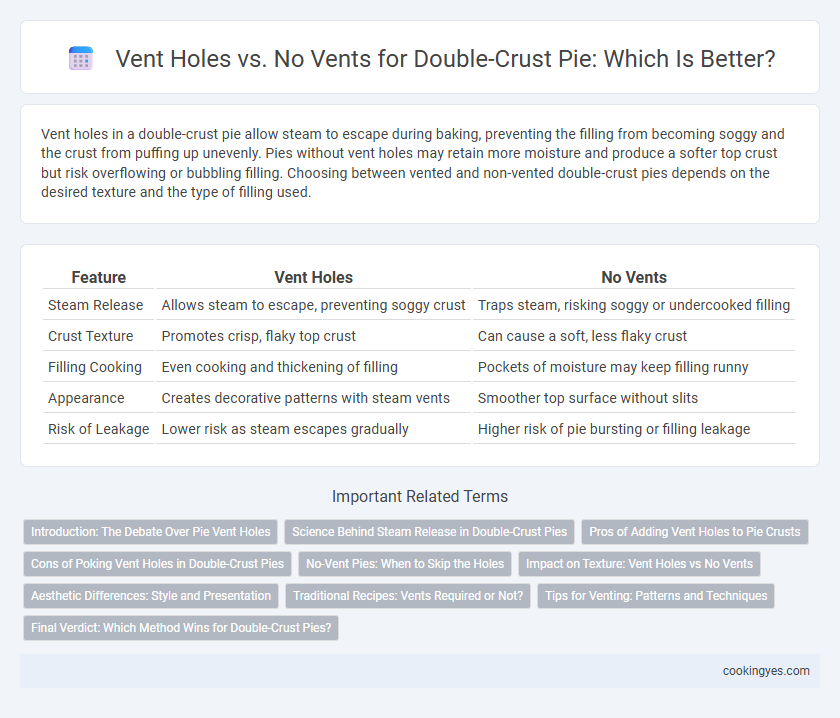Vent holes in a double-crust pie allow steam to escape during baking, preventing the filling from becoming soggy and the crust from puffing up unevenly. Pies without vent holes may retain more moisture and produce a softer top crust but risk overflowing or bubbling filling. Choosing between vented and non-vented double-crust pies depends on the desired texture and the type of filling used.
Table of Comparison
| Feature | Vent Holes | No Vents |
|---|---|---|
| Steam Release | Allows steam to escape, preventing soggy crust | Traps steam, risking soggy or undercooked filling |
| Crust Texture | Promotes crisp, flaky top crust | Can cause a soft, less flaky crust |
| Filling Cooking | Even cooking and thickening of filling | Pockets of moisture may keep filling runny |
| Appearance | Creates decorative patterns with steam vents | Smoother top surface without slits |
| Risk of Leakage | Lower risk as steam escapes gradually | Higher risk of pie bursting or filling leakage |
Introduction: The Debate Over Pie Vent Holes
Vent holes in double-crust pies regulate steam release, preventing soggy crusts and ensuring even baking. Without vents, steam can get trapped, causing the crust to puff up or crack unevenly during baking. Baker preferences and recipe types influence whether vent holes are used, balancing aesthetics and structural integrity.
Science Behind Steam Release in Double-Crust Pies
Vent holes in double-crust pies facilitate steam release, preventing excessive pressure buildup that can cause crust bursting or sogginess. Without vents, trapped steam condenses inside, leading to a moister filling but risking a soggy bottom crust and reduced flakiness. Properly placed vent holes balance moisture retention and crust texture by allowing controlled steam escape during baking.
Pros of Adding Vent Holes to Pie Crusts
Adding vent holes to double-crust pie crusts allows steam to escape during baking, preventing soggy fillings and reducing the risk of crust bubbling or cracking. Vent holes promote even cooking by maintaining proper moisture balance inside the pie, resulting in a golden, flaky texture. This technique enhances overall pie texture and appearance by ensuring a crisp bottom crust and a well-set filling.
Cons of Poking Vent Holes in Double-Crust Pies
Poking vent holes in double-crust pies can cause the filling to leak out during baking, resulting in a soggy, uneven crust. Vent holes may also allow steam to escape excessively, leading to a dry or overcooked top crust. Moreover, piercing the dough compromises the structural integrity, increasing the risk of collapsing or shrinking.
No-Vent Pies: When to Skip the Holes
No-vent pies are ideal for fruit fillings with high moisture content that release steam slowly, such as berry or custard pies, preventing drying out during baking. Skipping vent holes preserves a glossy, sealed crust and helps trap steam to cook the filling evenly without leakage. This technique reduces the risk of crust sogginess and maintains structural integrity in double-crust pies that rely on steam for internal pressure regulation.
Impact on Texture: Vent Holes vs No Vents
Vent holes in double-crust pies allow steam to escape, preventing soggy filling and promoting a crisp, flaky crust. Without vents, trapped steam can create a soggy texture in the bottom crust and cause uneven baking. Proper venting ensures balanced moisture release, resulting in a tender yet structurally sound pie crust.
Aesthetic Differences: Style and Presentation
Double-crust pies with vent holes showcase a classic, rustic appearance, allowing steam to escape while creating decorative patterns that enhance visual appeal. Pies without vents offer a smooth, seamless top crust, contributing to a sleek, polished presentation ideal for formal settings. The choice between vented and non-vented crusts directly impacts the pie's aesthetic, balancing traditional charm against refined elegance.
Traditional Recipes: Vents Required or Not?
Traditional double-crust pie recipes typically require vent holes to allow steam to escape during baking, preventing the crust from becoming soggy and ensuring a flaky texture. Without vents, trapped steam can cause the filling to bubble over or the crust to puff unevenly, affecting both appearance and taste. Some classic recipes specify small slits or decorative cutouts to balance steam release while maintaining a visually appealing top crust.
Tips for Venting: Patterns and Techniques
For double-crust pies, vent holes effectively release steam to prevent soggy crusts and bubbling fillings. Slits, lattice patterns, or decorative shapes can be used, balancing aesthetics with sufficient airflow. Optimal venting involves spacing cuts evenly and ensuring enough opening to allow steam escape during baking for a crisp, golden crust.
Final Verdict: Which Method Wins for Double-Crust Pies?
For double-crust pies, vent holes play a crucial role in preventing soggy bottoms by allowing steam to escape during baking, ensuring a crisp, golden crust. Pies without vents often trap moisture, leading to a soggy, undercooked top crust and uneven texture. Consistently, expert bakers recommend vented double-crust pies for optimal texture and flavor balance.
Vent holes vs no vents for double-crust pie Infographic

 cookingyes.com
cookingyes.com